
Seoul Subway Line 2, also known as the Circle Line, is a circular line of the Seoul Metropolitan Subway. The line running clockwise is called the "inner circle line" and the counter-clockwise line is called the "outer circle line". This is Seoul's most heavily used line, and consists of the main loop, the Seongsu Branch and the Sinjeong Branch for a total line length of 60.2 km (37.4 mi). The Line 2 loop is the third longest subway loop in the world after Moscow Metro Bolshaya Koltsevaya line and Beijing Subway Line 10. In 2019, Line 2 had an annual ridership of 812 million passengers or 2.2 million passengers per day.

Seoul Metropolitan Rapid Transit Corporation (SMRT) was established in 1994 to operate the Seoul Subway lines 5, 6, 7, 8 in Seoul, South Korea.
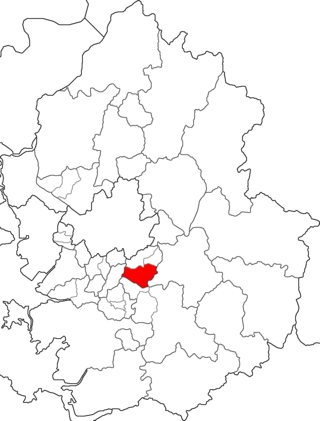
Bundang-gu (Korean: 분당구) is the largest and most populous district (gu) of Seongnam, a major city in the Seoul Capital Area, South Korea. Bundang-gu is one of South Korea's wealthiest and highest developed areas, being the nation's first and largest completely artificial city built in the early 1990s. Many high-rise luxury condos moved in the early 2000s, with a second planned city built in the late 2000s called Pangyo in the same district. Apartment prices are the second highest in Gyeonggi-do after Gwacheon and 7th highest nationwide, higher than many central Seoul districts such as Mapo-gu or Jongno-gu. Apartments around Pangyo station and the high-rise luxury condos around Jeongja station and Sunae station rival prices in the most expensive areas in the country. Unlike older cities such as Seoul, Bundang has no telephone poles overground, resulting in a clean cityscape with well-designed streets.

Guui Station (Korean: 구의역) is a station on the Seoul Subway Line 2. Because of its proximity to the Gwangjin District Office, it is also known as Gwangjin-gu Office Station.
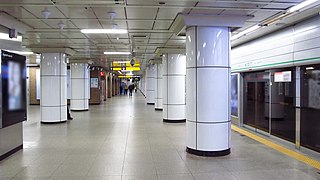
Sadang Station is a station on the Seoul Subway Line 2 and Seoul Subway Line 4 in South Korea.

Seoul National University Station is a station on Seoul Subway Line 2, located in Bongcheon-dong, Gwanak-gu of southern Seoul. This station is also known as Gwanak-gu Office Station. There are eight exits, two at each corner of the crossroads – of Nambu Beltway (Nambusunhwan-ro) and Gwanak-ro – where the station lies beneath.

Sindorim station is a station on Seoul Subway Line 1 and Line 2 (underground). It is also the southeastern terminus of Line 2's Sinjeong Branch to Kkachisan. The station is located at the northern edge of Sindorim-dong, Guro-gu, Seoul, on the border with Yeongdeungpo-gu.
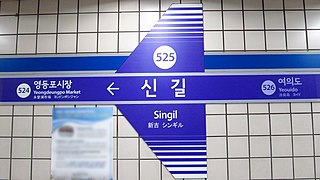
Singil Station is a station on the Seoul Subway's Line 1 and 5.

Seongdong District (Seongdong-gu) is one of the 25 gu which make up the city of Seoul, South Korea. It is situated on the north bank of the Han River. It is divided into 20 dong (neighbourhoods).

Danggogae Station (Korean: 당고개역) is a station on Line 4 of the Seoul Metropolitan Subway network. It was the northern terminus of Line 4, until 19 March 2022, when the line was extended to Jinjeop. It is an elevated station. The name of the subway station comes from its local name. Regional names refer to the pass that travelers carried over because of wild animals.
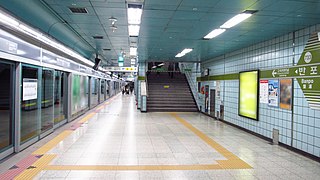
Banpo Station is a metro station on Seoul Subway Line 7 located in Jamwon-dong, Seocho-gu, Seoul. Despite its name, the station is not located in Banpo-dong, but instead in Jamwon. It has 6 entrances that they are all right side entrance and they have screen doors right before entering the train. It takes 4~8 minutes between 2 trains and next stations are Nonhyeon and Seoul Express Bus Terminal. It is only 500m long between Banpo station and two other Stations next to it. The station number is 733.

Jayang station is a metro station on Seoul Subway Line 7. It is located in Jayang-dong in the Gwangjin-gu administrative district of Seoul. It is the only station in South Korea to be located on the underside of a bridge, beneath Cheongdam Bridge. The station also runs underneath a highway with two exits being south of the highway and two north. The south exits serve Ttukseom Hangang Park, while the north exits serve Jayang 3-dong and Jayang 4-dong which contain some residential towers with small shops and other mixed commercial and residential areas. The station is serviced by a single bus route which is located at exit 4. Before Line 7 opened the station was known as Jayang Station (자양역).

Chang-dong Station is a station on Seoul Subway Line 1 and Line 4. It is located in Chang-dong, Dobong-gu, Seoul. A shopping center was planned for this site, but the empty lot has never been developed due to the bankruptcy of the contractor behind said project. The station is, however, home to a cluster of pojangmacha stalls.
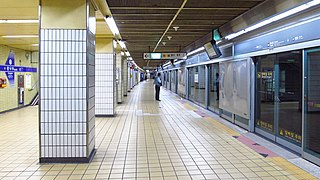
Gwangnaru Station is a station on the Seoul Subway Line 5 in Gwangjin-gu, Seoul. Its station subname is Presbyterian Univ. & Theological Seminary, where said university is nearby Exit 2.

Gil-dong Station is a subway station on Seoul Subway Line 5 in Gangdong-gu, Seoul. There is a connecting track from this station to Dunchon-dong Station on the Macheonji Line of Line 5, but it is a return train track for the arrival and departure of the Godeok Vehicle Business Office and has nothing to do with passenger operations.

Amsa-dong is a dong (neighbourhood) of Gangdong-gu in Seoul, South Korea. The dong is well known for the Amsa-dong Prehistoric Settlement Site, in which Neolithic remains were excavated after a large amount of diagonal-line patterned earthenware(Korean:빗살무늬토기) was exposed by a flood in 1925. It is thought to be a Jomonic settlement which existed prior to the spread of Songgukri-cultural sphere in Korean peninsula during the Korean bronze age. In Amsa Sam-dong, a festival named Amsa sunsa cultural festival is hold annually and parade is performed. It has a subway station of Seoul metropolitan subway 8th line, which functions as the last station of the line. There is only one high school in Amsa-dong named Sunsa highschool. The neighborhood is also known for its large traditional market. Amsa dong is divided in three, Amsa il-dong, Amsa I-dong, Amsa Sam-dong, and community centre is present in every one of these divisions. It is currently part of Gangdong-Gu of Seoul metropolitan city adminstration.

Gubeundari Station is a subway station on Seoul Subway Line 5 in Gangdong-gu, Seoul.
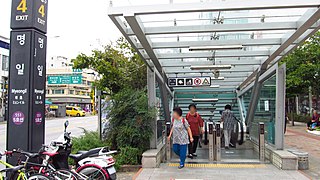
Myeongil Station is a subway station on Seoul Subway Line 5 in Gangdong-gu, Seoul.

Suji-gu (Korean: 수지구), or Suji, is one of the three city districts in Yongin City, South Korea which is approximately 29 km south of Seoul. Suji became a city district on October 31, 2005, about nine years after Yongin officially became a city. When Yongin City was established in 1996, both urban and rural areas were covered to become a part of the city; thus to this day, Yongin's urbanization is varied throughout different regions of the city. Suji is one of the most urbanized areas of Yongin, as it borders Seongnam City's Bundang District and Suwon City, two more well developed areas. Home to the newly built Shinsegae Department Store and Dankook University in one of its towns, Jukjeon, Suji is rapidly developing as Yongin City becomes more and more urbanized. In recent years, the district has attracted upper-class Koreans, with the completion of the Samsung East Palace in 2010.
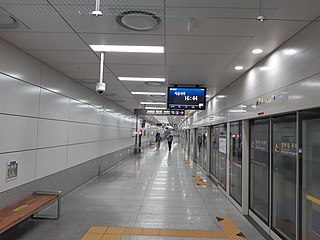
Gangil Station (Korean: 강일역) is a subway station on the Hanam Line of Seoul Subway Line 5, located in Gangdong-gu, Seoul.





















